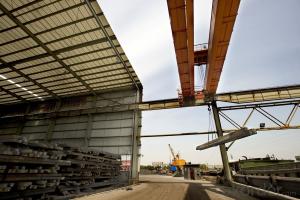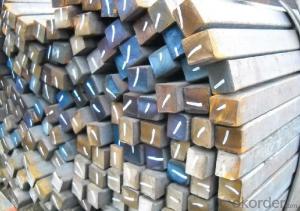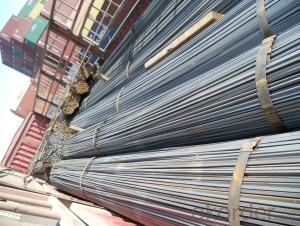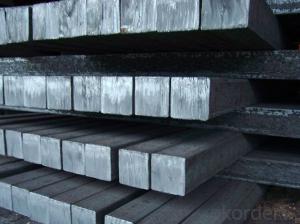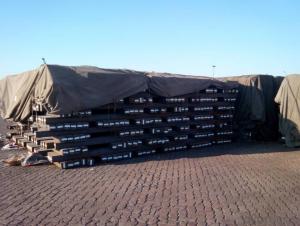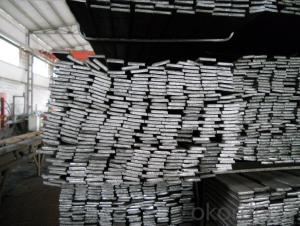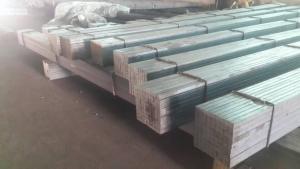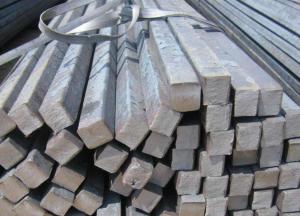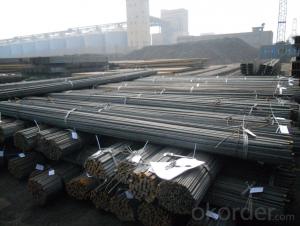Hot Rolled Carbon Steel Square Bar with Many Sizes
- Loading Port:
- China Main Port
- Payment Terms:
- TT or LC
- Min Order Qty:
- -
- Supply Capability:
- -
OKorder Service Pledge
OKorder Financial Service
You Might Also Like
Product Description:
OKorder is offering Square Bar at great prices with worldwide shipping. Our supplier is a world-class manufacturer of steel, with our products utilized the world over. OKorder annually supplies products to European, North American and Asian markets. We provide quotations within 24 hours of receiving an inquiry and guarantee competitive prices.
Product Applications:
-The Square Steel is normally used as structure steel.
-Row material for other structure steel like steel angles, channels, I-beams, H-beams, etc…
Product Advantages:
OKorder's Square Bar are durable, strong, and resist corrosion.
Main Product Features:
· Premium quality
· Prompt delivery & seaworthy packing (30 days after receiving deposit)
· Corrosion resistance
· Can be recycled and reused
· Mill test certification
· Professional Service
· Competitive pricing
Product Specifications:
1. Grade: Q195, Q235, Q345
2. Diameter: 6mm-150mm
3. Length: 6m, 9m, 12m or as customer’s request
4. Tolerance: Within ±5% for weight; ±2mm for diameter
5. Note: The price can be better is the quantity is good
6. Chemical composition
Standard | Grade | Element (%) | ||||
C | Mn | S | P | Si | ||
GB | Q195 | 0.06~0.12 | 0.25~0.50 | ≤0.050 | ≤0.045 | ≤0.30 |
GB | Q235B | 0.12~0.20 | 0.30~0.70 | ≤0.045 | ≤0.045 | ≤0.30 |
-Mechanical Properties:
Mechanical Properties | Grade | Steel diameter(mm) | |||
≤16 | 16~40 | 40~60 | 60~100 | ||
Yield Point Δs/MPa | Q195 | ≥195 | ≥185 | - | - |
Q235 | 235 | 225 | 215 | 205 | |
Tensile Strength | Q195 | 315~390 | |||
Q235 | 375~500 | ||||
Elongation δ5% | Q195 | ≥33 | ≥32 | - | - |
Q235 | 26 | 25 | 24 | 23 | |
Length of a side(mm) | Theoretical weight(kg/m) | Length of a side(mm) | Theoretical weight(kg/m) |
53 | 22.05 | 80 | 50.24 |
56 | 24.61 | 85 | 56.72 |
60 | 28.26 | 90 | 63.59 |
63 | 31.16 | 95 | 70.85 |
70 | 38.49 | 100 | 78.50 |
75 | 44.16 |
Payment:
-Invoicing on theoretical weight or actual weight as customer’s request.
-FOB, CFR or CIF.
-Regular terms of payment:
1, 30% payment in advance, the remaining balance (70% payment) against the copy of B/L.
2, 30% payment in advance, the remaining balance (70% L/C) against the copy of B/L.
3, Negotiable.
FAQ:
Q1: Why buy Materials & Equipment from OKorder.com?
A1: All products offered byOKorder.com are carefully selected from China's most reliable manufacturing enterprises. Through its ISO certifications, OKorder.com adheres to the highest standards and a commitment to supply chain safety and customer satisfaction.
Q2: How do we guarantee the quality of our products?
A2: We have established an advanced quality management system which conducts strict quality tests at every step, from raw materials to the final product. At the same time, we provide extensive follow-up service assurances as required.
Q3: Can stainless steel rust?
A3 Stainless does not "rust" as you think of regular steel rusting with a red oxide on the surface that flakes off. If you see red rust it is probably due to some iron particles that have contaminated the surface of the stainless steel and it is these iron particles that are rusting. Look at the source of the rusting and see if you can remove it from the surface.
nickel and molybdenum enhance this surface layer and improve the corrosion resistance of the stainless material.
Images:
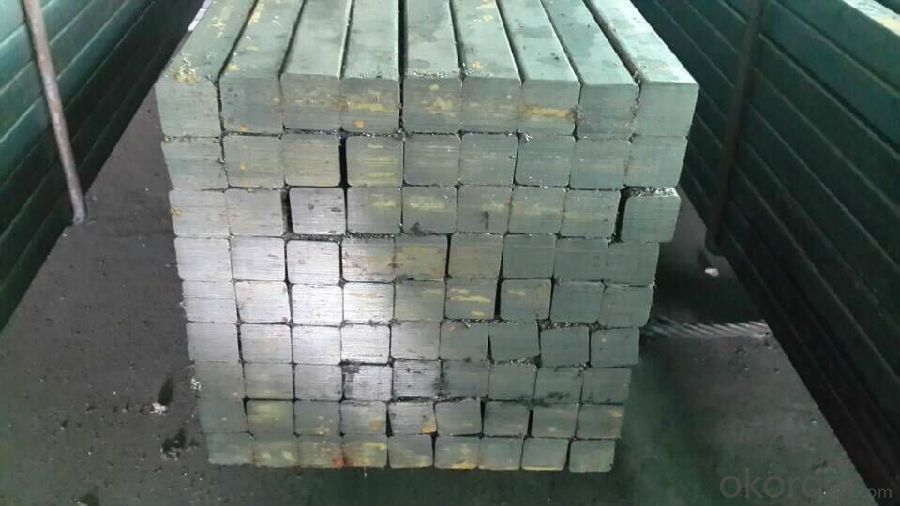
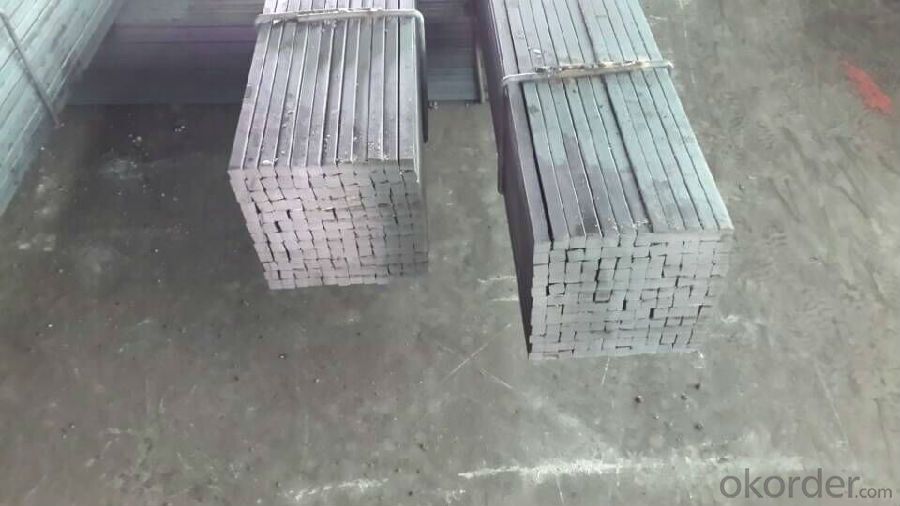
- Q: How do you use a steel square to determine the rise and run of stairs?
- To accurately determine the rise and run of stairs, one can utilize a steel square and follow the subsequent instructions: 1. Commence by measuring the total rise, which refers to the vertical height from the starting floor of the stairs to the ending floor. This measurement is crucial. 2. Divide the total rise by the desired height of each step to ascertain the number of steps required. Round off this number to the nearest whole number and adjust the height of each step accordingly. 3. Calculate the rise of each step by dividing the total rise by the number of steps. This will provide the vertical distance between each step. 4. To determine the run, the horizontal distance covered by each step, employ the steel square. Position the square's shorter leg, known as the blade, against the vertical rise line, and the longer leg, known as the tongue, against the horizontal floor. Ensure that the square remains level. 5. Slide the square along the rise line, maintaining the blade against the rise and the tongue against the floor. Once the square aligns with the total run, mark the horizontal line where the tongue intersects with the rise line. Repeat this process for every step. 6. Determine the tread depth by measuring the distance from the back of the preceding step to the front of the next step. This measurement indicates the horizontal depth covered by each step. By adhering to these steps and utilizing a steel square, one can accurately determine the rise and run of stairs, thus guaranteeing the creation of a safe and comfortable staircase design.
- Q: How do you store a steel square properly?
- To store a steel square properly, there are a few key steps you should follow. Firstly, ensure that the square is clean and dry before storing it. Any moisture or dirt on the square can lead to corrosion over time. Next, find a suitable storage location that is cool, dry, and away from direct sunlight or extreme temperature changes. Ideally, you should store the square in a tool cabinet, toolbox, or on a dedicated shelf. This will protect it from accidental damage and prevent it from getting lost or misplaced. When storing a steel square, it is important to avoid any contact with other metal tools or materials that can cause scratches or dents. To prevent potential damage, you can wrap the square in a clean, soft cloth or place it in a protective case or sleeve. Additionally, you may consider applying a light coat of oil or rust preventive spray on the steel square before storing it. This will create a thin barrier that helps prevent oxidation and corrosion. However, be cautious not to apply excessive oil or use a type that can attract dust or dirt. Lastly, it is crucial to check on the square periodically, especially if it is not frequently used. Regular inspections will allow you to identify any signs of rust or damage early on, so you can address them promptly. By following these guidelines, you can ensure that your steel square remains in good condition and ready for use whenever you need it.
- Q: How do you use a steel square to check for squareness?
- Typically, when checking for squareness using a steel square, the following steps are followed: 1. Ensure that the steel square is securely and evenly placed on a flat surface, such as a workbench or table. 2. Align one edge of the steel square with the surface you want to assess for squareness. This could be the edge of a wooden piece, a wall, or any other object that should ideally form a perfect 90-degree angle. 3. Examine the corner where the two edges of the steel square intersect. If the object you are evaluating is square, the two edges should create a flawless 90-degree angle. 4. To guarantee accuracy, you may utilize a measuring tape or ruler to measure the distance between the two edges of the steel square at various points along the edges. If the object is square, the measurements should be equal. 5. Repeat these steps on different sides or corners of the object to ensure overall squareness. If the steel square consistently exhibits a perfect 90-degree angle, then the object is square. It is essential to note that while a steel square is a trustworthy tool for assessing squareness, it is vital to have a flat and even surface to obtain accurate results. Additionally, some steel squares may include additional features, such as a level or a lip, which can provide further assistance in checking for squareness.
- Q: How do you use a steel square to determine the length of a stair tread?
- In order to determine the length of a stair tread using a steel square, the first step would be to measure the rise and run of the stairs. The rise refers to the vertical height between two consecutive steps, while the run is the horizontal distance from the front to the back of a step. Once you have obtained these measurements, you can proceed to calculate the length of the stair tread using the steel square. The steel square is a versatile measuring tool that consists of a long metal blade and a shorter perpendicular blade, forming the shape of an "L." To calculate the length of the stair tread, please follow the following steps: 1. Place the steel square along the edge of the step, ensuring that the long blade aligns with the rise and the shorter blade aligns with the run. 2. Verify that the blades of the steel square are perfectly aligned with the edge of the step. 3. Use a pencil or marker to make a mark at the point where the long blade intersects the front edge of the step. 4. Repeat this process for each step, making sure that the steel square is correctly aligned each time. 5. Measure the distance between the marked points on each step. This measurement represents the length of the stair tread. It is important to bear in mind that while the steel square provides an accurate measurement, it is always prudent to verify your calculations and measurements to ensure precision. Additionally, it is advisable to consult the building codes or regulations specific to your area in order to comply with any requirements pertaining to stair tread lengths.
- Q: Can a steel square be used for checking the squareness of a concrete form?
- Indeed, the squareness of a concrete form can be checked by employing a steel square. In construction, steel squares are frequently employed to gauge and confirm right angles. It is crucial to guarantee that the steel square is appropriately aligned with the concrete form's edges when utilizing it. By positioning the steel square alongside the form's edges, one can verify the perfect squareness of the corners and make adjustments if needed. This practice aids in guaranteeing the precise shape of the concrete form prior to pouring the concrete, ultimately leading to a superior final product.
- Q: How do you use a steel square to check for plumbness?
- To use a steel square to check for plumbness, follow these steps: 1. Start by making sure the steel square is clean and free of any debris or rust. Wipe it down if necessary. 2. Hold the steel square against the vertical surface that you want to check for plumbness. Make sure it is resting firmly against the surface. 3. Look at the corner of the steel square where the two arms meet. This corner should be perfectly square, with a 90-degree angle. 4. Observe the edge of the steel square that is aligned with the vertical surface. If the surface is perfectly plumb, the edge of the square should align perfectly with it from top to bottom. 5. If the edge of the square does not align with the surface, it means that the surface is not plumb. Take note of how much it deviates from the square and make adjustments accordingly. 6. To correct the plumbness, you can use shims or adjust the surface until it aligns properly with the edge of the steel square. 7. Repeat the process at multiple points along the vertical surface to ensure consistency and accuracy. By using a steel square to check for plumbness, you can ensure that your vertical surfaces are straight and aligned correctly, which is crucial for various construction and woodworking projects.
- Q: How do you use a steel square to measure and mark 281.25-degree angles?
- To use a steel square to measure and mark a 281.25-degree angle, you would first align one edge of the square with a reference line. Then, locate the degree markings on the square and find the 281.25-degree mark. Place a mark or draw a line at that point on your work surface to indicate the desired angle.
- Q: How do you use a steel square to measure and mark 185.625-degree angles?
- In order to measure and mark a 185.625-degree angle using a steel square, a series of steps must be followed. To begin, locate the steel square's 90-degree angle, which is created by the long side (blade) and the short side (tongue). This specific angle is commonly denoted by a right angle symbol (90°). Following that, align the blade of the steel square with one of the sides of the angle that requires measurement. Confirm that the tongue is perpendicular to the blade and extending in the opposite direction. Subsequently, rotate the steel square until the edge of the tongue intersects with the other side of the desired angle. Ensure that the blade remains aligned with the first side. At this stage, the measurement of the desired angle can be observed on the tongue of the steel square. Nevertheless, due to the absence of markings beyond 90 degrees on a steel square, a protractor or another tool with smaller increments may be necessary to determine the precise measurement of 185.625 degrees. Once the correct angle has been determined, a pencil or another marking tool can be used to make the corresponding mark on the workpiece. It is important to exercise caution and maintain stability of the square during the marking process to prevent any inaccuracies.
- Q: Can a steel square be used for checking the squareness of a roof truss?
- Yes, a steel square can be used for checking the squareness of a roof truss. A steel square, also known as a framing square or carpenter's square, is a versatile tool that is commonly used in construction. It consists of a long blade and a shorter tongue, which are perpendicular to each other. To check the squareness of a roof truss, the steel square can be placed at the joint where the truss members meet. By aligning the blade of the square along one side of the truss and the tongue along the adjacent side, you can determine if the angle formed by these sides is 90 degrees or not. If the truss is square, the blade and tongue of the steel square should align perfectly with the sides of the truss, forming a right angle. However, if the truss is not square, the blade and tongue will not align properly, indicating that the truss is out of square and may require adjustment. It is important to note that while a steel square can provide a quick and convenient way to check the squareness of a roof truss, it is always recommended to use other measuring tools and methods, such as laser levels or plumb bobs, to ensure accuracy. Additionally, consulting with a professional or an engineer is advised for complex or critical structural elements like roof trusses.
- Q: How do you use a steel square to mark a line parallel to a board edge?
- To mark a line parallel to a board edge using a steel square, adhere to the following instructions: 1. Align one of the steel square's edges with the board's edge. 2. Securely hold the steel square in position, making sure it remains stable. 3. Position a pencil or marking tool against the steel square's opposite edge. 4. While maintaining contact between the pencil and the steel square's edge, cautiously glide it along the square's length. 5. As the pencil moves, it will leave a mark on the board, parallel to its edge. 6. Continue sliding the pencil until the desired length or distance on the board is marked. 7. After marking the line, verify its parallelism by measuring the same distance at various points along the line. Employ a tape measure or ruler for accurate verification. By utilizing a steel square and adhering to these instructions, you can effortlessly mark a line parallel to a board edge. This technique proves particularly beneficial in carpentry and woodworking projects where precision plays a crucial role.
Send your message to us
Hot Rolled Carbon Steel Square Bar with Many Sizes
- Loading Port:
- China Main Port
- Payment Terms:
- TT or LC
- Min Order Qty:
- -
- Supply Capability:
- -
OKorder Service Pledge
OKorder Financial Service
Similar products
Hot products
Hot Searches
Related keywords
